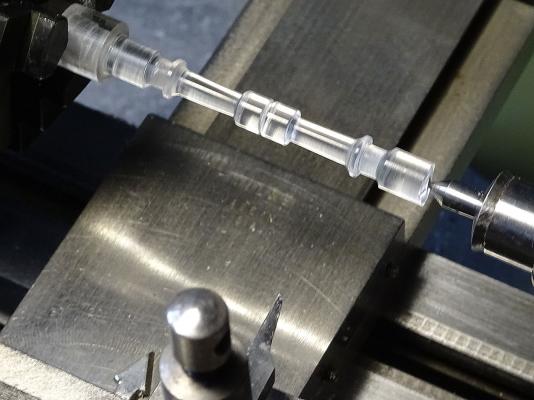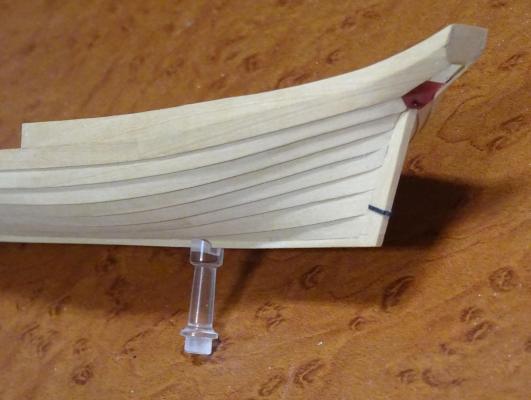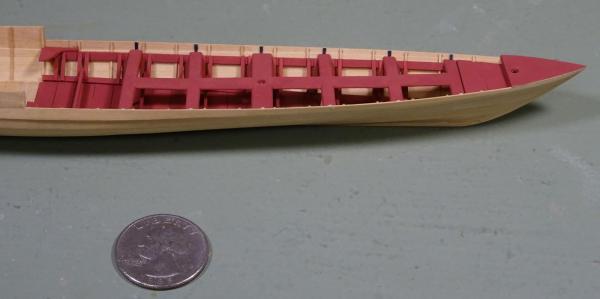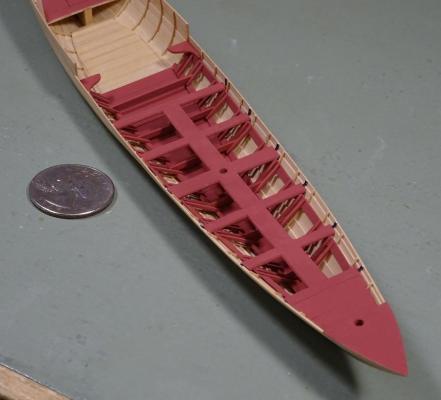-
Posts
13,274 -
Joined
-
Last visited
Content Type
Profiles
Forums
Gallery
Events
Everything posted by druxey
-
I thought that they might be goosenecks for stunsail booms, but she is fore-and-aft rigged....
-
Generally, Humbrol should be dry in hours, not weeks! It may be a combination of both factors mentioned, both temperature and humidity.
- 7 replies
-
- paint
- drying time
-
(and 1 more)
Tagged with:
-
Normally aft station lines blend smoothly into the keel/deadwood structure. An angle, such as you show, will be impossible to plank. On another note, you should be able to save a 'screen grab' - rather than take off-axis photos of your screen.
- 525 replies
-
- anchor hoy
- hoy
-
(and 1 more)
Tagged with:
-
Question: which set of waterlines fair properly with the station sections and a proof diagonal or two?
- 525 replies
-
- anchor hoy
- hoy
-
(and 1 more)
Tagged with:
-
Bensid: Yes, that is a Boley watchmaker's/jeweler's lathe that I use. This particular model has a collet-bearing tailstock, which is a big advantage. The standard scale that I build models at is the classic 1:48. Open boats look quite small at this scale!
- 641 replies
-
- greenwich hospital
- barge
-
(and 1 more)
Tagged with:
-
Another minor update: The underwater hull has been refined and the gudgeons added. The lower gudgeon is conventional, but the upper one on the transom is a small eyebolt. This was often the case with open boats. I looked at photographs of extant ceremonial barges and noticed that the transoms were invariably painted. It was an awkward job to do at this stage of the build, but I was successful using a 00 sable brush. The mounting of the model now needed to be considered. I decided to make a simple pair of pedestals in clear acrylic. These were turned, then polished. I was filing the keel slot in the second of these when one side cracked off. I had to repeat the set-up to produce a duplicate piece. Grrr!
- 641 replies
-
- greenwich hospital
- barge
-
(and 1 more)
Tagged with:
-

Cutter Cheerful 1806 by rafine - FINISHED
druxey replied to rafine's topic in - Build logs for subjects built 1801 - 1850
Coming along really nicely, Bob. Very neatly done.- 525 replies
-
- cheerful
- Syren Ship Model Company
-
(and 1 more)
Tagged with:
-
Those are very acceptable looking strops, Toni. Is there enough length to hook both ends of the frapped side tackle, though? If the gun is run out, those tackle would be cast off ready for action.
- 1,449 replies
-
Silver is very malleable, but work hardens fairly quickly. However, it is easily annealed and worked further.
-
Cunning dodge, Bill, on the poop deck bulkhead! Had you not pointed it out, I doubt if anyone would have noticed. Your secret is safe with us! Lovely work on those rails.
- 382 replies
-
- sovereign of the seas
- carving
-
(and 1 more)
Tagged with:
-
Thank you again, all, for visiting this log and for your comments. A small update. The corner seats forward of the coach have been made and installed. These were some trouble, and I made three sets before I was satisfied. Running the moulding along the edges where the grain direction changed was difficult, as there was a tendency for tear-out. Instead of wooden standards uniting the thwarts and sides, there are iron straps. On Prince Frederick's barge, the arm of the strap that runs across the thwart is inset flush to the thwart's surface. The side arm is bent as appropriate over the inner sides of the planking. This detail completes the structures in the rowing section. While the model is invertible without risk, I shall be cleaning up the outer sides of the planking and softening the edges of the laps. It is also time to make and fit the gudgeons.
- 641 replies
-
- greenwich hospital
- barge
-
(and 1 more)
Tagged with:
-
The jeweller's saw is an incredibly useful tool. Use it with a bench birdsmouth ('V') board. Follow Jesse's advice and you can't go far wrong.
-
Well,it looks like you are making up for lost time, Toni. Nice to see you back again.
- 1,449 replies
-
Sorry to hear of your neck problems, Nils. Hope you can get effective treatment. Best wishes.
- 2,625 replies
-
- kaiser wilhelm der grosse
- passenger steamer
-
(and 1 more)
Tagged with:
-
Nicely coiled and hung, Chuck. Looks very convincing. Well done!
- 1,051 replies
-
- cheerful
- Syren Ship Model Company
-
(and 1 more)
Tagged with:
-
Clean and ship-shape work as usual, Mike. Very nice indeed.
- 452 replies
-
- cheerful
- Syren Ship Model Company
-
(and 1 more)
Tagged with:
About us
Modelshipworld - Advancing Ship Modeling through Research
SSL Secured
Your security is important for us so this Website is SSL-Secured
NRG Mailing Address
Nautical Research Guild
237 South Lincoln Street
Westmont IL, 60559-1917
Model Ship World ® and the MSW logo are Registered Trademarks, and belong to the Nautical Research Guild (United States Patent and Trademark Office: No. 6,929,264 & No. 6,929,274, registered Dec. 20, 2022)
Helpful Links
About the NRG
If you enjoy building ship models that are historically accurate as well as beautiful, then The Nautical Research Guild (NRG) is just right for you.
The Guild is a non-profit educational organization whose mission is to “Advance Ship Modeling Through Research”. We provide support to our members in their efforts to raise the quality of their model ships.
The Nautical Research Guild has published our world-renowned quarterly magazine, The Nautical Research Journal, since 1955. The pages of the Journal are full of articles by accomplished ship modelers who show you how they create those exquisite details on their models, and by maritime historians who show you the correct details to build. The Journal is available in both print and digital editions. Go to the NRG web site (www.thenrg.org) to download a complimentary digital copy of the Journal. The NRG also publishes plan sets, books and compilations of back issues of the Journal and the former Ships in Scale and Model Ship Builder magazines.







